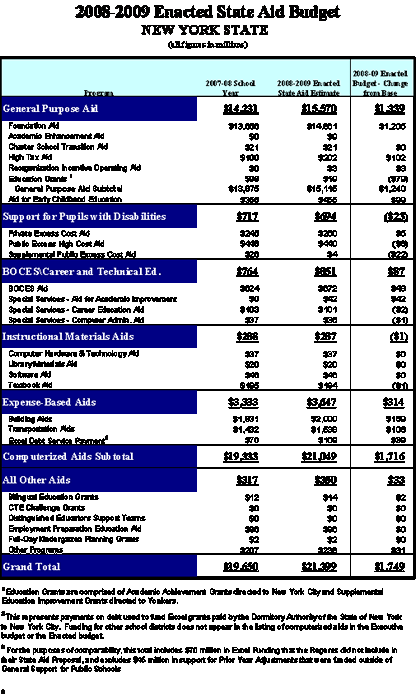Meeting of the Board of Regents | May 2008
|
|
|
|
TO: |
Subcommittee on State Aid |
|
FROM: |
Johanna Duncan-Poitier |
|
SUBJECT: |
2008-09 State Budget - State Aid to School Districts |
|
DATE: |
May 2, 2008 |
|
STRATEGIC GOAL: |
2 and 5 |
|
AUTHORIZATION(S): |
|
SUMMARY
Issue for Discussion
What are the key State Aid provisions of the 2008-09 State Budget? What directions do the Regents want to take in their 2009-10 State Aid Proposal?
Reason(s) for Consideration
For Information.
Proposed Handling
This question will come before the Subcommittee on State Aid at its May 2008 meeting.
Procedural History
The Regents adopted their State Aid Proposal for 2008-09 in October 2007. The Executive Budget Proposal was released on January 22, 2008 and final agreement on the 2008-09 State Budget was reached on April 9, 2008. At the April 2008 meeting of the Board of Regents, the Regents received information on the 2008-09 State Budget and requested additional detail concerning the State Aid provisions.
Background Information
See attached item.
Recommendation
N/A
Timetable for Implementation
This discussion will inform the development of the Regents 2009-10 State Aid proposal which will be finalized in the fall of 2008.
Attachment
ATTACHMENT 1
HIGHLIGHTS OF THE 2008-09
ENACTED BUDGET
SCHOOL AID
The 2008-09 Enacted Budget for State Aid to public schools is consistent with the goals advocated in the Regents State Aid Proposal.
- General Support for Public Schools (GSPS) is $21.37 billion, an increase of $1.73 billion or 8.8% over the 2007-08 school year. The enacted budget also adds $102.1 million to the Executive’s $100.2 million High Tax Aid proposal.
- Most districts share in the overall increase. The increase for the median district is 8.3%, and the median for the need resource categories is at roughly the same level, except for High Need Urban/Suburban Districts and Low need Districts, where the median increase is in excess of 10%.
- Overall, the Computerized Aids continue to be focused on high need school districts, although not to the extent recommended by the Regents or the Executive. At the time the 2007-08 budget was enacted, it was estimated that 64.7% of the increase was directed to high-need districts; for 2008-09, the comparable portion is 66.8%.
- The phase-in of Foundation Aid and funding for Universal Prekindergarten programs are continued.
- The Budget continues support for Contracts for Excellence and proposes additional refinements, including an expansion of allowable activities to include programs to improve the achievement of English Language Learners and inclusion of the Regents recommendation that schools entering into a contract do so for a three year period
Key Formula Provisions for 2008-09 School Year
- Foundation Aid
The phase-in of the new Foundation Aid formula and of Universal Prekindergarten is continued. With respect to Foundation Aid, the enacted budget maintains the existing minimum increase of 3%. The overall funding level for Foundation Aid increases from $13.7 billion to $14.9 billion, an increase of 8.8% or $1.2 billion.
- Regents/Executive Proposal to reduce the due-minimum to a 2% year-to-year increase was rejected, and the 3% due-minimum was continued. This provided an extra $16.5 million, of which 72% benefited low and average need districts.
- The Regents proposal recommended continuing the existing 25% limit on year-to-year increases. The enacted budget reduced that cap to 15%. This reduces State Aid by an additional $10.9 million, with the impact split evenly between high need and other districts.
- The rate at which Foundation Aid is to be phased in was slowed down, so that districts receive 37.5% of their final increase, rather than 42.5%. This does not appreciably change the fully phased-in formula, but it reduced aid for 2008-09 by almost $272 million, of which 79% or nearly $215 million is absorbed by high need districts.
- This also makes the task of fully phasing in the formula by 2010-11 more difficult, by deferring the fiscal impact. Over the first two years of the phase-in, Foundation Aid has increased by $1.2 to $1.2 billion per year. It is estimated that for the final two years, aid will have to increase by $1.7 billion to $1.8 billion per year.
- Support for Early Childhood Education
Funding for Universal Prekindergarten is increased as well. Current estimates for the 2007-08 school year indicate that grants will total approximately $354 million. Districts are estimated to be eligible for $450-455 million in 2008-09, an increase of approximately $95-99 million, or 27%.
- The 2008-09 formula for determining the maximum grants available and the number of districts to be served is very similar to that proposed by the Executive. It expands both the number of districts eligible for grants and the number of children to be served.
- On the other hand, the 2008-09 budget provides only for a single year of funding. There is no statutory commitment to a continued or expanded program, unlike the Regents and Executive proposals that provided for a phased-in program that would be available to all four-year-olds by 2010-11.
- Of the new funding, about $54.7 million, or 57%, is directed toward high-need districts. This proportion is likely to decrease as program eligibility expands to encompass more low-need districts.
- The Regents had also proposed that districts be afforded some flexibility to utilize funds for full-day programs. This request was not carried forward, and the desire to offer longer programs is likely to remain an issue.
- BOCES Aid
The enacted budget maintains the present formula provisions for BOCES Aid. BOCES Aid increases from $623.6 million to $672.2 million, an increase of $48.6 million or 7.8%.
- Career and Technical Education Aid
Special Service Aid for Academic Improvement (which provides aid for career education activities and administrative computer services to the Big Five and other districts that are not components of BOCES) is increased by $42 million. These special aids are provided in lieu of aid payable to other school districts for career education and administrative uses of technology purchased as shared services and aided through BOCES. A school district receiving aid under this category may not claim BOCES Aid for similar services/purchases. These districts are entitled to aid for certain career education pupils in grades 10-12.
- Building Aid
The enacted budget continues the current computation of building aid ratios. Building Aid increases from $1,830.5 million to $2,000.5 million, an increase of $170.0 million or 9.3%.
- Bilingual Education Aid
The enacted budget also recommends a $2.0 million increase in Bilingual Education Grants, for total funding of $13.5 million. The increase will be used to replicate model programs including a Two-Way Bilingual Education program designed to integrate limited English proficient (LEP) students with English proficient students in an instructional program which uses two languages for instruction. Approximately $1.4 million will be distributed through a competitive grant process. In addition, approximately $600,000 will be used for Bilingual/ESL Supplementary Intervention grants that focus on tutorial programs that help LEP students meet NYS standards and graduation requirements. An announcement of Requests for Proposals (RFPs) is scheduled to be posted on the Department Website on July 9, 2008.
- High Tax Aid
The one-year High Tax Aid provision that was enacted for 2007-08 was replaced with a new formula that provides more targeted support to districts that have relatively high residential property tax levies in proportion to district income and higher-than average spending per pupil. Of the $102 million increase, 34% benefited high-need districts. Although this increase was not particularly well-focused on high-need districts, it represents an improvement over the 2007-08 formula, of which 18% accrued to high need districts.
On a regional basis, High Tax Aid remains highly focused on Long Island. In 2007-08, 70% of the High Tax Aid flowed to that region; in 2008-09, the corresponding share would be 69%.
- New Aids
Two new formula aids were created for the 2008-09 school year, Academic Enhancement Aid and Special Services Aid for Academic Improvement. Both are general purpose aid (unrestricted money that can be used for any legal purpose), are relatively small amounts within the context of $21.4 billion in General Support for Public Schools, and are focused on a relatively few districts -- ten in all, including the Big Five.
- Special Services Aid for Academic Improvement was enacted as proposed by the Executive. It provides $41.9 million in additional funds to districts that are not components of BOCES, and primarily benefits the Big Five. For 2008-09, about $18.7 million, or 45% of the total allocation flows to New York City, the Big Four receive $19.4 million or 46%, and the remaining 9% benefits two high-need small cities, Albany and Newburgh.
- An additional $9.0 million in Academic Enhancement Aid is directed toward districts which have been deemed Districts In Need of Improvement for at least five years, and which have a Foundation Aid increase of less than ten percent. The only districts identified as eligible are Central Islip, Hempstead, Syracuse and Wyandanch.







 THE STATE EDUCATION DEPARTMENT / THE UNIVERSITY OF THE STATE OF NEW YORK / ALBANY, NY 12234
THE STATE EDUCATION DEPARTMENT / THE UNIVERSITY OF THE STATE OF NEW YORK / ALBANY, NY 12234